What if we could provide children with building blocks that not only enhance their creativity but also foster their learning? The answer lies in a world of endless possibilities where imagination takes flight.
These building blocks serve as the foundation for a child’s cognitive development, enabling them to explore, experiment, and problem-solve. Through tactile engagement, children develop fine motor skills, spatial awareness, and hand-eye coordination.
In this article, we will share some recommendations for building blocks, along with their benefits, and provide some tips to assist you. Let’s start building!
Table of contents
Introduction
Building blocks play a crucial role in a child’s development, offering a myriad of benefits and learning outcomes. Most kids nowadays spend the majority of their free time in front of screens, engrossed in gadgets. If you’re looking for some physical and fun toy recommendations for kids, building blocks can be your children’s best choice. All it takes is choosing the best and most suitable building blocks for your kids.
Building with blocks often leads to collaborative play. Children communicate, negotiate, and share ideas while working together, honing their social and communication skills. This cooperative play is an excellent example of games for kids that encourage interaction, also this bridges the gap between playtime and educational activities for kids.
Building blocks promote creativity and imagination, allowing children to create structures, solve problems, and experiment with different arrangements. This open-ended play encourages critical thinking, problem-solving, and logical reasoning. Additionally, language and communication skills are nurtured as children engage in collaborative play, sharing ideas and building narratives.
Overall, building blocks provide a holistic learning experience that supports cognitive, physical, and social-emotional development in children.
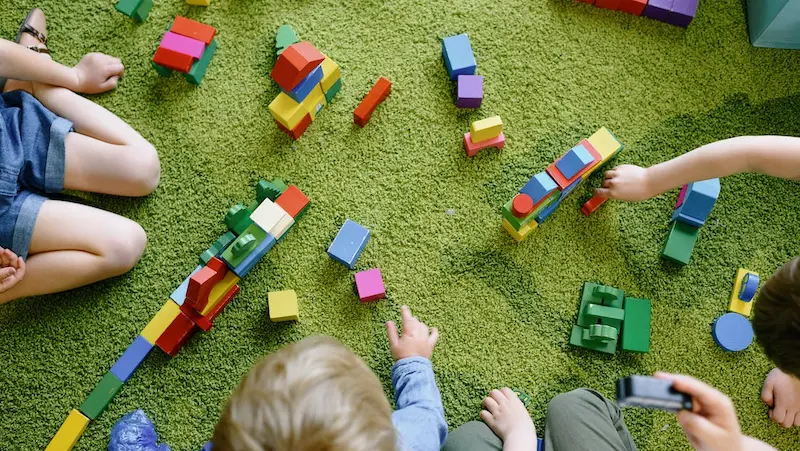
Types of Building Blocks
There is a wide variety of building blocks available in the market, each offering unique features and suitability for different age groups. Here are a few types:
1. Wooden Blocks: These classic building blocks are typically made of natural wood and come in various shapes and sizes. They are durable, eco-friendly, and provide a tactile experience. Wooden blocks are suitable for children of all ages, promoting open-ended play, creativity, and fine motor skills.
2. Plastic Blocks: Plastic building blocks, such as LEGO, Mega Bloks, or DUPLO, are popular due to their versatility and compatibility. They often have interlocking mechanisms, allowing for complex constructions. Plastic blocks are available in different sizes and colors, appealing to younger children (1-6 years) as well as older kids. They encourage imaginative play, problem-solving, and spatial skills.
3. Magnetic Blocks: Magnetic building blocks use magnets to connect pieces, providing a unique building experience. They offer stability and ease of assembly, making them suitable for younger children (3-8 years). Magnetic blocks enhance fine motor skills, creativity, and spatial awareness.
4. Foam Blocks: Foam blocks are soft and lightweight, making them safe for toddlers and young children (1-4 years). They are often larger in size, making them easier to grasp and stack. Foam blocks promote sensory exploration, imaginative play, and basic engineering concepts.
5. Electronic Blocks: Electronic building blocks, like those from LittleBits or Snap Circuits, introduce children (8 years and older) to basic electronics and coding. These blocks have built-in sensors, motors, and connectors that can be programmed to create functioning circuits. They foster STEM skills, problem-solving, and logical thinking.
6. Cardboard Blocks: Cardboard building blocks are lightweight, eco-friendly, and often come in large sizes. They are suitable for children of various ages, promoting creativity, gross motor skills, and imaginative play. Cardboard blocks can be decorated and customized, adding an additional layer of engagement.
When choosing building blocks, consider the age appropriateness, safety features, durability, and the specific developmental skills you want to enhance. It’s also beneficial to have a mix of block types to provide a diverse and stimulating play experience for children.

Benefits of playing with building blocks
Building blocks offer a multitude of cognitive, motor, and social development benefits for children. Let’s explore each aspect in detail:
1. Cognitive Development
– Problem-Solving: Building blocks present children with problems to solve, such as figuring out how to balance or construct stable structures. Research shows that block play enhances problem-solving skills.
– Spatial Skills: Manipulating blocks helps develop spatial awareness, understanding of shapes, and visual-motor coordination. A study found that block play was positively correlated with spatial ability in preschoolers.
– Mathematical Thinking: Building structures involves concepts like symmetry, geometry, and counting. Block play has been linked to improved math skills in early childhood.
2. Motor Development
– Fine Motor Skills: Picking up, stacking, and manipulating blocks improves hand-eye coordination and fine motor skills. A study showed that block play significantly improved fine motor skills in preschoolers.
– Gross Motor Skills: Building large structures requires whole-body movements, promoting gross motor development. Children might crawl, walk, or balance while engaging in block play.
3. Social Development
– Cooperative Play: Building blocks often invite collaboration and cooperative play, encouraging children to share ideas, negotiate, and work together. This fosters social skills, empathy, and teamwork. The research found that cooperative block play enhanced social skills and cooperative behavior.
– Language Development: Block play provides opportunities for conversation, storytelling, and vocabulary expansion as children discuss their creations. Social interaction during block play supports language development.
– Emotional Development: Block play allows children to express their ideas, creativity, and emotions, fostering emotional development and self-regulation. Additionally, engage children in mindfulness exercises and teach them patience through block-building. Encourage them to focus on each piece, promoting presence and concentration. This serves as a form of mindfulness exercise for kids.
Moreover, it is the one of the best growth mindset activities for kids because, building blocks offer a safe space for trial and error which encourage a growth mindset by celebrating both successes and failures, emphasizing that learning comes from both experiences.
Introduce themes that align with children’s interests, such as animals, cities, or space. This approach stimulates their curiosity and encourages them to explore new subjects. Creating themed structures can also be seen as a form of puzzle-solving, integrating puzzles for kids with creative play.
Real-life examples further demonstrate these benefits. For instance, when children collaborate to build a bridge with blocks, they discuss and problem-solve together, honing their communication and critical thinking skills. As they experiment with different block arrangements to create a stable tower, they develop spatial awareness and scientific thinking. Furthermore, when children engage in block play in a group, they learn to take turns, share materials, and respect others’ ideas, nurturing their social skills.
Multiple studies support these benefits, highlighting the positive impact of block play on cognitive, motor, and social development in children. Incorporating building blocks into early childhood settings and encouraging their use at home can provide a rich and stimulating environment for children to thrive and grow.
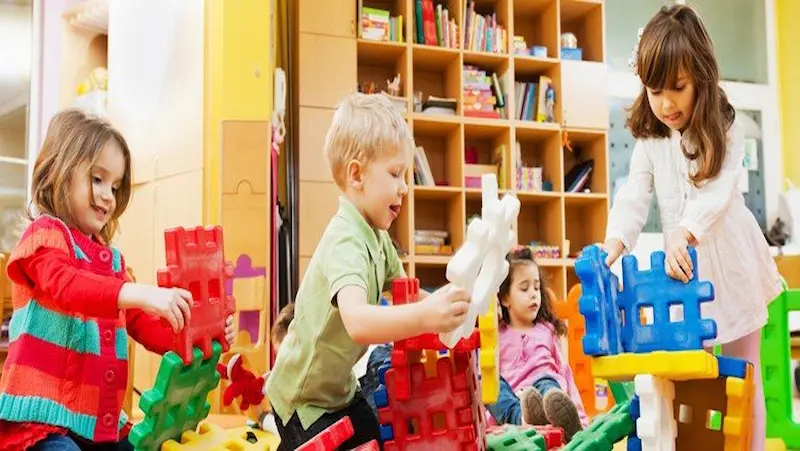
Choosing the Right Building Blocks
There are a lot of factors to consider when choosing blocks for kids, but here are the most important ones:
1. Age appropriateness
Most building blocks have age labels that are important to consider before making a purchase. Buying blocks intended for an age higher than the kids’ age can pose potential dangers, and they may also become less interested, as toys are designed to cater to specific age stages of kids.
2. Safety considerations
Some safety issues need to be considered, such as the size and the use of non-toxic materials, to avoid potential choking hazards or poisoning. Blocks with rounded edges are also considered safer, as they lower the risk of injury. Another important factor is the material’s durability since kids may play vigorously, and if the blocks are not durable enough, they could break apart, potentially causing harm to the kids. Look for certifications like ASTM (American Society for Testing and Materials) or CE (Conformité Européene) to ensure compliance with safety standards.
3. Educational value
Some building blocks are designed very simply and can only create basic structures. However, there are other blocks that are ingeniously designed to offer endless possibilities for creating structures, ranging from simple to advanced ones. Additionally, for younger kids, there are blocks available that feature educational images, text, or numbers, providing a learning experience while they play!
4. Material and durability
Durability is an important factor, as kids can sometimes play quite roughly. Wood blocks are generally more durable than plastic ones, but they typically lack interlocking studs, which limit the building possibilities. Plastic building blocks are lighter and hollow, but if you choose from reputable and popular brands, they can still be highly durable.
5. Size and Ease of Use
Consider the size and weight of the blocks. For younger children, larger blocks are easier to handle and less of a choking hazard. Ensure that the blocks are lightweight enough for your child to manipulate comfortably.
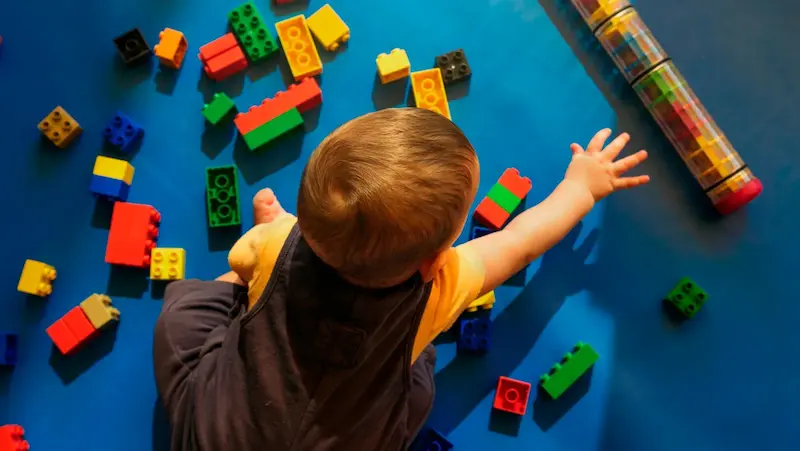
Educational Building Blocks
Educational building blocks are specifically designed to combine play and learning, offering a range of benefits for children’s cognitive development. These blocks incorporate educational elements such as numbers, letters, shapes, colors, and STEM concepts, providing a well-rounded learning experience. Here are some popular brands and specific products that offer educational elements:
1. LEGO Education: LEGO offers a range of educational building sets that promote creativity, problem-solving, and STEM skills. Their sets include themes like robotics, engineering, coding, and science. For example, the LEGO Education EV3 set allows children to build and program their own robots, introducing them to coding and engineering principles.
2. Mega Bloks First Builders: Mega Bloks First Builders sets are specifically designed for toddlers and preschoolers. These blocks feature colorful designs, numbers, and letters to introduce early math and literacy concepts while promoting fine motor skills and creativity.
3. Magformers: Magformers are magnetic building blocks that foster spatial reasoning, geometry, and critical thinking. The magnetic connection allows children to create various 3D structures and explore concepts like symmetry and problem-solving. Magformers also offer specialized sets focused on STEM subjects like mathematics and engineering.
4. Tegu: Tegu blocks are wooden magnetic blocks that encourage creativity, problem-solving, and fine motor skills. They offer sets with unique shapes, patterns, and magnets that provide endless possibilities for construction and imaginative play.
5. Learning Resources Gears! Gears! Gears!: This building set features gears and colorful interlocking pieces that enable children to create moving structures. It promotes critical thinking, and cause-and-effect relationships, and introduces basic engineering concepts.
6. Clicformers: Clicformers are click-together building blocks that inspire creativity, fine motor skills, and spatial awareness. They offer sets with specialized pieces for constructing vehicles, animals, and more, encouraging imaginative play and problem-solving.
These educational building blocks engage children in hands-on learning experiences, enhancing their cognitive abilities, fine motor skills, and critical thinking. They also promote creativity, collaboration, and the development of STEM skills. When selecting educational building blocks, consider your child’s interests, age, and specific learning goals to choose the most suitable set for their educational journey.
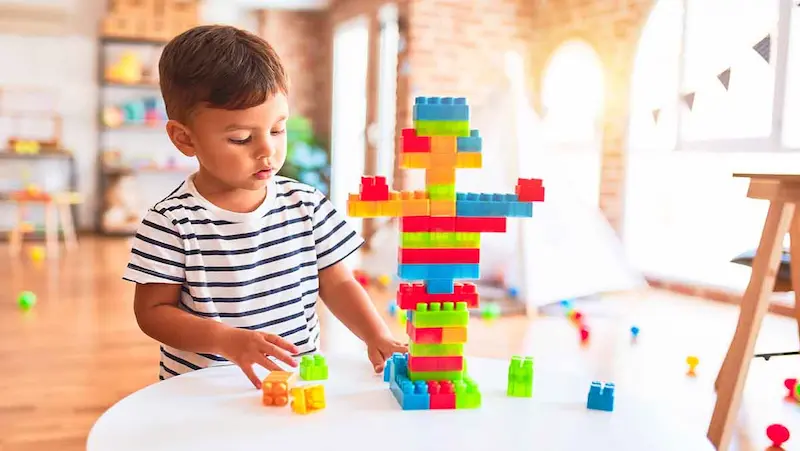
Promoting Creativity and Learning
To encourage creativity during play with building blocks, here are some practical tips and activity ideas:
1. Provide Open-Ended Materials: Offer a variety of building blocks in different shapes, sizes, and materials. This allows for more possibilities and encourages children to think creatively while building.
2. Build Together: Engage in collaborative building sessions with your child. Take turns adding blocks and sharing ideas. This not only fosters creativity but also strengthens the parent-child bond.
3. Encourage Problem-Solving: Pose challenges or problems for your child to solve using the blocks. For example, ask them to build a bridge that can hold a certain weight or construct a tower using only a specific set of blocks. This stimulates critical thinking and creativity.
4. Promote Storytelling: Encourage your child to create narratives or stories around their block creations. This helps develop their imagination, language skills, and narrative abilities. Ask questions about their structures to prompt storytelling.
5. Explore Different Themes: Introduce themed building challenges to spark creativity. For example, build a castle, a spaceship, or a zoo using blocks. This provides a framework for imaginative play and encourages thinking outside the box.
6. Add Other Materials: Combine building blocks with other materials like cardboard tubes, fabric scraps, or toy figurines to enhance the play experience. Encourage your child to incorporate these additional elements into their block constructions, promoting innovation and creativity.
7. Document and Display Creations: Take photos or videos of your child’s block creations and display them in a designated area. Celebrate their achievements and encourage them to reflect on their work. This fosters a sense of pride and accomplishment, motivating further creativity.
8. Provide Uninterrupted Playtime: Allow for uninterrupted block play where your child has ample time to explore, experiment, and immerse themselves in their creations. This promotes deep engagement and creativity without time constraints.
As a parent, your role in fostering a positive and engaging building block experience is crucial. Here are some additional tips:
– Be a Facilitator: Offer guidance, support, and encouragement during play. Help your child overcome challenges and celebrate their successes. Be an active participant in their imaginative play and encourage them to express their ideas.
– Create a Safe and Inspiring Environment: Set up a dedicated play area with easy access to building blocks and other materials. Keep the space organized and clutter-free, allowing for focused and creative play.
– Provide Inspiration: Share books, videos, or images that showcase impressive block creations. Attend local block-building events or visit museums or exhibitions that feature block sculptures or architectural designs. This exposure to inspiring examples can spark your child’s creativity.
– Balance Structure and Freedom: While providing some guidance and suggestions, allow your child the freedom to explore and create without too many constraints. Balancing structure and freedom nurtures their independence and originality.
– Value the Process: Focus on the process of building rather than just the end result. Encourage your child to experiment, take risks, and learn from their mistakes. Emphasize that creativity is about enjoying the journey of exploration and self-expression.
By following these tips and actively participating in your child’s block play, you can foster a positive and engaging experience that nurtures their creativity, problem-solving skills, and imagination.

Reviews and Recommendations
Here are some reviewed and recommended building block sets suitable for different age ranges and interests:
1. For Toddlers (1-3 years)
– Mega Bloks First Builders: These large, colorful blocks are perfect for little hands. They promote fine motor skills, creativity, and early construction concepts.
2. Preschoolers (3-5 years)
– LEGO DUPLO Creative Play: With larger pieces and vibrant colors, these sets engage preschoolers in imaginative play and basic building skills. Themes like animals, vehicles, and buildings offer a wide range of options.
– Tegu Magnetic Wooden Blocks: Tegu blocks are a unique blend of natural wood and magnets. They offer creativity, fine motor development, and open-ended play.
3. Early Elementary (6-8 years)
– LEGO Classic Creative Bricks: This set includes a variety of LEGO bricks in different shapes and colors, encouraging creativity and problem-solving. It offers endless possibilities for building and imaginative play.
– Magformers Basic Set: Magformers’ magnetic blocks promote spatial awareness, creativity, and critical thinking. The Basic Set provides the foundation for constructing 3D shapes and structures.
4. Upper Elementary (9-12 years)
– LEGO Architecture: This series allows children to build iconic structures from around the world, combining creativity with an introduction to architectural concepts. It promotes spatial reasoning, attention to detail, and appreciation for design.
– K’NEX Education Sets: K’NEX offers sets that combine building with engineering concepts. They include gears, pulleys, and motors, allowing children to create working machines while learning about mechanics and structural integrity.
5. STEM Enthusiasts (8+ years)
– LEGO Mindstorms: This robotics system combines building, coding, and engineering. It enables children to build and program their own robots, promoting creativity, problem-solving, and advanced STEM skills.
– littleBits Rule Your Room Kit: littleBits offers electronic building blocks that introduce children to circuits and electronics. The Rule Your Room Kit encourages creativity and problem-solving as children design and build their own inventions.
Remember to consider the age appropriateness, interests, and learning goals of your child when selecting a building block set. These recommendations provide a starting point for engaging and educational play experiences.

Conclusion
In conclusion, building blocks for kids and code games for kids offer numerous benefits and serve as excellent educational toys for children. They stimulate cognitive functions, teach basic physics, unleash creativity, improve memory, and foster responsibility.
By incorporating building blocks into playtime, children can reduce screen time and engage in safe and creative play. Building blocks also enhance social skills and instill competitiveness and a willingness to embrace challenges. To maximize the benefits, it is important to consider age appropriateness, safety considerations, educational value, and material durability when choosing the best blocks for children.
Building blocks are far more than mere toys; they are invaluable tools for fostering creativity, cognitive growth, and various essential skills in children. The act of constructing, experimenting, and inventing with blocks lays a strong foundation for future learning and development. So, whether it’s stacking wooden blocks or constructing intricate LEGO masterpieces, these building blocks, combined with various fun activities for kids, brain teasers for kids, and engaging board games for kids, will continue to shape the minds and futures of our children in remarkable ways.
By encouraging collaborative play, exploring landmarks, and introducing problem-solving challenges, children can further enhance their learning and enjoyment. So, explore the world of building blocks and unlock the endless possibilities!
Also, BrightChamps provides a comprehensive platform for learning about money for kids, offering interactive and engaging resources that teach financial literacy, budgeting, saving, and other essential money management skills.
Frequently Asked Questions
Building blocks for kids promote cognitive development, spatial skills, problem-solving abilities, creativity, fine motor skills, and social interaction, fostering overall learning and development in a fun and engaging manner.
Kids enjoy building blocks from around the age of one, as their fine motor skills are quite developed. However, parental guidance is crucial to prevent any potential hazards.
Consider the size (larger blocks are safer and easier to clean up), material (choose safe and durable options), and versatility (select blocks with a wide range of building possibilities).
Yes, there are educational building blocks available that incorporate numbers, letters, shapes, colors, and STEM concepts to provide a learning-focused play experience for children.
The endless building possibilities empower children to unleash their creativity and imagination in order to construct entirely new creations that have never before existed.
There are various types of building blocks available, including LEGO, Mega Bloks, Tegu, Magformers, and K’NEX, each offering unique features, materials, and building systems to cater to different preferences and age ranges.

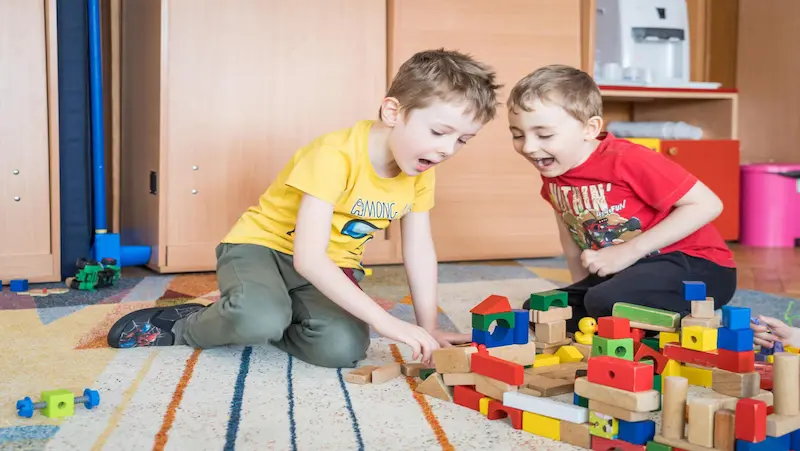
 We are an army of educators and passionate learners from BrightChamps family, committed to providing free learning resources to kids, parents & students.
We are an army of educators and passionate learners from BrightChamps family, committed to providing free learning resources to kids, parents & students.








